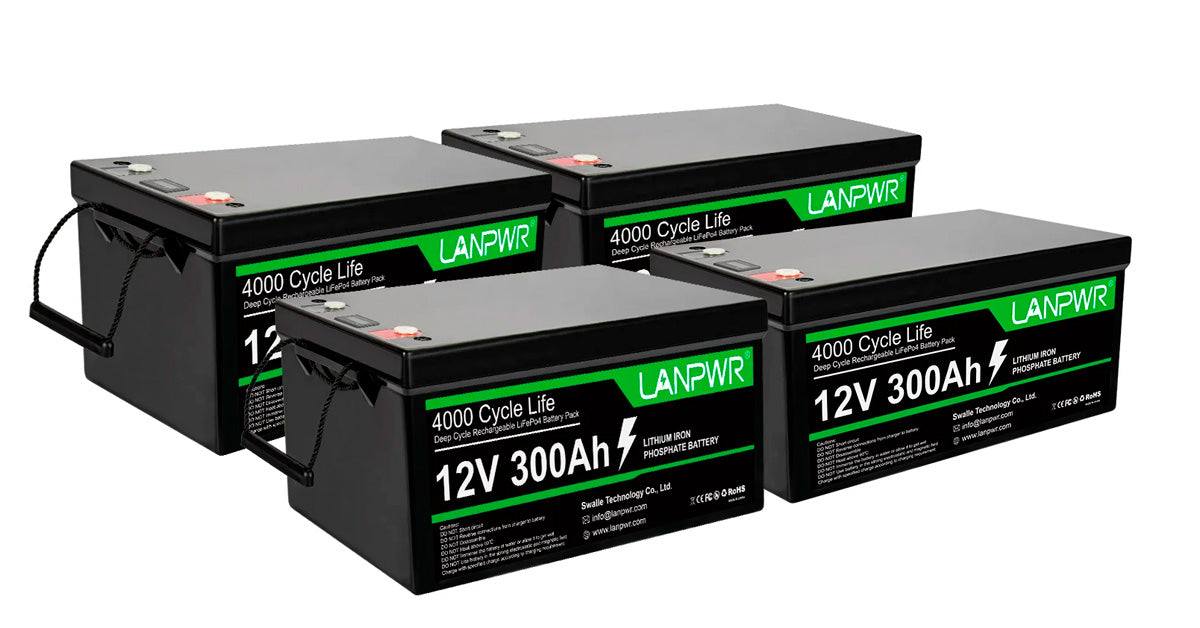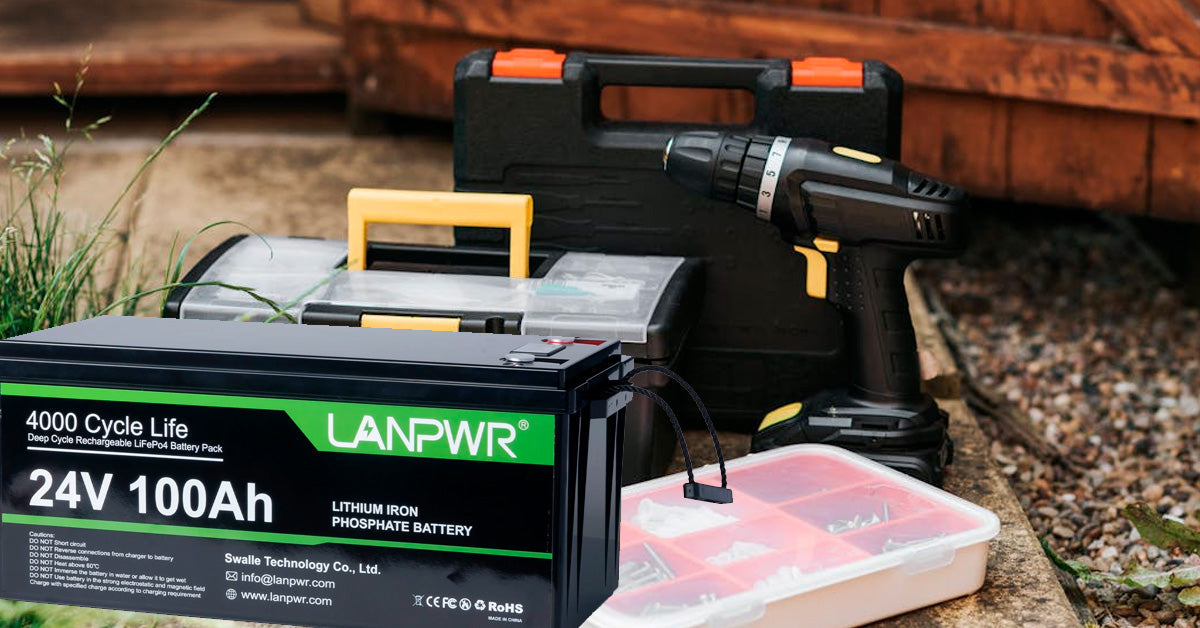"Explore the pivotal role of high-quality batteries in solar energy storage systems. Learn how advanced battery technologies enhance efficiency, reliability, and longevity, enabling sustainable power solutions. Discover key innovations and trends shaping the future of renewable energy storage."
In the quest to harness the sun's abundant power, the efficiency with which we capture and subsequently store this energy becomes paramount. Solar energy stands as a cornerstone among renewable energy sources, necessitating advanced battery storage systems to amplify its effectiveness and practicality. The deployment of high-caliber batteries, such as the acclaimed LANPWR battery, is essential in this integration, ensuring solar power's position as a formidable and sustainable energy alternative. These storage solutions not only stabilize the energy supply but also optimize the financial and environmental benefits of solar technology.
Understanding Solar Energy and Its Storage Needs
The Basics of Solar Energy
At the forefront of renewable energy solutions are solar panels, which utilize photovoltaic cells to convert sunlight directly into electricity. This process is fundamental to the operation of solar systems and is critical for converting solar energy from a mere possibility into a tangible, usable form of power. The photovoltaic cells in these panels capture solar radiation and transform it into electrical energy, which is essential for powering homes, and businesses, and even supporting large-scale utility networks.
The efficiency of these panels and their ability to convert sunlight effectively dictates the overall productivity of solar energy systems. Advances in photovoltaic technology have significantly improved the conversion efficiency of these panels over the years, enhancing their capacity to generate more electricity from the same amount of sunlight. This increase in efficiency is vital for the broader adoption of solar technology, as it makes solar energy a more viable and competitive alternative to conventional energy sources.
Why Store Solar Energy?
Due to the day-night cycle and variability in weather conditions, the inherent intermittency of solar power necessitates the storage of solar energy. This intermittency challenges the consistent availability of solar power, leading to potential gaps in energy supply. Solar battery storage systems provide a buffer that ensures a continuous energy supply regardless of sunlight availability by storing surplus energy produced during peak sunlight hours. This stored energy can be used during periods of low sunlight, ensuring a stable and reliable energy supply.
This capability not only stabilizes energy output but also enhances the utility and efficiency of solar power, making it more comparable to traditional energy sources in terms of reliability. By mitigating the unpredictability of solar power, storage systems play a crucial role in integrating solar energy into the mainstream energy grid. These systems enable solar to meet a larger proportion of energy demands consistently, thereby supporting a transition to a more sustainable and less carbon-dependent energy infrastructure.
Types of Batteries Used in Solar Energy Storage
Overview of Solar Batteries
In the realm of solar power systems, solar batteries are essential components for energy storage. Their primary function is to store the electrical energy produced by solar panels during daylight. This capability is crucial as it allows the stored energy to be utilized during periods when sunlight is insufficient, such as nighttime or cloudy days. By maintaining a consistent energy supply, these batteries play a vital role in enhancing the operational efficacy of solar installations, ensuring that the energy needs are met even when solar production is low.
Common Types of Solar Batteries
- Lithium Ion Batteries: Within the solar industry, lithium-ion batteries are highly regarded for their superior efficiency and longevity. These batteries offer significant advantages in terms of energy density and discharge efficiency, which are essential for maximizing the performance of solar energy systems. They are at the forefront of solar storage technology, driven by ongoing technological advancements that aim to mitigate their inherent challenges. While lithium-ion batteries are associated with higher costs and potential safety risks, such as thermal runaway, continuous improvements are enhancing their safety and cost-effectiveness, making them increasingly viable for broader applications.
- Flow Batteries: Flow batteries are distinguished by their exceptional scalability and longevity, which make them particularly suitable for large-scale solar energy storage applications. One of the unique features of flow batteries is the ability to decouple power from energy capacity, allowing these systems to increase their energy storage capacity independently of their power output. This feature is advantageous in scenarios where long-duration energy storage is beneficial, such as in large installations or applications requiring a stable and reliable energy supply over extended periods. The scalability and reliability of flow batteries offer substantial benefits in terms of operational flexibility and system efficiency.
Key Features of High-Quality Battery Storage Systems
Battery Capacities
Battery capacity is a pivotal aspect of battery storage systems, dictating the amount of energy that can be stored. This characteristic is crucial for determining the overall efficiency and utility of a solar power system. For instance, high-capacity batteries such as the LANPWR models are essential for systems that need to support substantial energy demands.
These high-capacity units ensure that solar installations are not just capturing solar energy but are also adequately equipped to store and utilize large volumes of it for sustained periods. To further optimize storage capabilities, it is important to consider battery lifespan and depth of discharge (DoD) alongside capacity. For example, a battery rated for 10 kWh with a DoD of 90% effectively provides 9 kWh of usable energy.
Cost Considerations
The cost-effectiveness of a battery storage system is not solely about the initial investment but also encompasses the long-term savings it can facilitate. Initial costs of high-capacity and technologically advanced battery systems can be significant, but these are often offset by the resultant savings on utility bills and reduced dependence on grid power.
When evaluating costs, it's essential to include the lifecycle cost analysis, which considers purchase price, installation, maintenance, and the expected lifespan. Comparing various battery types—such as lead-acid versus lithium-ion—provides insight into which option offers the best return on investment for specific applications, factoring in efficiency, durability, and scalability.
Safety and Efficiency
Safety is paramount in the design and operation of solar battery storage systems, particularly with the adoption of technologies like lithium-ion batteries. The risks of thermal runaway and other safety-related incidents necessitate robust safety mechanisms. Recent advances in battery technology have significantly improved the safety features of systems, such as the inclusion of built-in fire suppression mechanisms and improved thermal management. Furthermore, efficiency enhancements, like improved charge and discharge rates, help maximize energy usage without compromising safety. An example of this advancement is the implementation of smart management systems in LANPWR batteries that monitor battery health and optimize charging cycles to enhance safety and efficiency.

Implementing a Solar Battery Storage System
Designing a Solar Battery System
Designing an effective solar battery system is a complex task involving integrating various critical components, each serving a distinct purpose in the overall system. The key components to consider include:
- Solar Panels: These are the primary source of energy collection. The selection of solar panels should be based on their efficiency ratings and compatibility with the area's climatic conditions.
- Batteries: As energy storage units, batteries must be chosen based on their capacity, lifespan, and type (e.g., lithium-ion vs. lead-acid). The choice directly impacts the performance and scalability of the system.
- Controller: This component regulates the flow of electricity from the solar panels to the batteries, ensuring that the batteries charge efficiently and safely without being overcharged.
- Inverter: The inverter converts the DC electricity stored in the batteries into AC electricity, which is usable in household or commercial settings.
The design process must account for several critical factors to ensure a harmonious integration of these components:
- System Size: Determined by the energy needs of the property, which should be carefully evaluated to ensure the system can handle peak and average loads.
- Geographic Characteristics: These include factors such as sunlight hours, angle of sunlight, and weather conditions, which influence the efficiency of solar panel operations.
Installation and Maintenance
The longevity and operational efficiency of a solar battery storage system largely depend on the quality of its installation and the diligence of its maintenance schedule. Key considerations include:
- Ventilation: Adequate space around components to prevent overheating.
- Protection: Measures to safeguard against environmental damage, such as waterproofing and dust protection.
- Ongoing Maintenance: Regular maintenance is essential to sustain high performance and extend the lifespan of the system. Maintenance activities include:
- Periodic Inspections: Regular checks to ensure all components function properly.
- Performance Monitoring: Using software or monitoring tools to track system performance and identify any deviations from normal operations.
- Component Servicing: Includes cleaning of solar panels, checking connections, and testing system outputs to ensure everything is operating at full capacity.

Economic and Environmental Impact of Solar Battery Storage
Cost Effectiveness of Solar Batteries
The economic assessment of solar batteries hinges on key performance indicators like return on investment (ROI) and the break-even period. These metrics are pivotal in illustrating the financial prudence of integrating solar storage solutions. Initially, the upfront costs of solar batteries might appear significant, but when analyzed over their operational lifespan, the return on investment becomes increasingly favorable. This favorable ROI is primarily due to the reduction in electricity bills and dependency on utility providers, as solar batteries allow for the storage and use of solar energy even during non-sunny hours.
Further, the time required to reach the break-even point—the moment when the savings from the investment equal the initial outlay—is a critical factor for investors and homeowners alike. Studies consistently show that as the efficiency of solar technology improves and the cost of solar components decreases, the break-even time shortens, thereby enhancing the attractiveness of solar batteries as a viable economic investment. This shift towards cost-effectiveness is encouraging more individuals and businesses to adopt solar energy solutions, driving forward the economic viability of sustainable energy technologies.
Environmental Benefits
Solar batteries offer considerable environmental advantages by facilitating a decrease in the dependency on fossil fuels, a major source of greenhouse gas emissions. This transition to solar energy storage systems significantly lowers the carbon footprint associated with traditional energy production methods. By enabling more widespread use of renewable energy, solar batteries ensure that clean, green energy is available even during peak demand times or in conditions where sunlight is minimal, thereby consistently reducing the amount of carbon emissions.
Moreover, the shift towards solar battery technology supports broader sustainability goals by promoting an energy landscape that is not only less reliant on environmentally harmful practices but also more resilient to the fluctuations of the traditional energy market. This move towards a cleaner energy matrix is crucial in combating climate change and plays a vital role in achieving global environmental targets. With increased awareness and technological advancements, the role of solar batteries in fostering a sustainable and environmentally friendly energy future becomes ever more pronounced.
The integration of high-quality batteries like LANPWR into solar energy storage systems is not merely about enhancing energy efficiency; it represents a pivotal shift towards a more sustainable and resilient energy future. Continued innovations in battery technology promise further improvements in efficiency, safety, and viability, propelling solar energy to the forefront of sustainable energy solutions.
Individuals contemplating the adoption of solar power should consider high-quality storage options like LANPWR batteries to maximize their investment. For further information and guidance, a plethora of resources is available to assist in making informed decisions about solar energy storage solutions.














Leave a comment
This site is protected by hCaptcha and the hCaptcha Privacy Policy and Terms of Service apply.